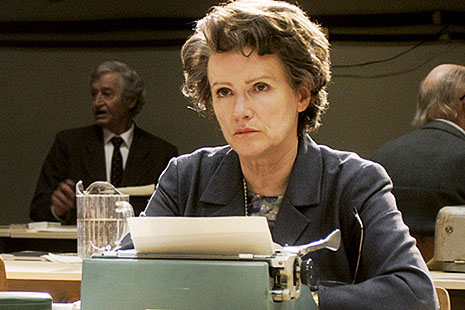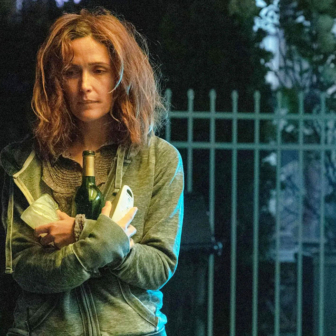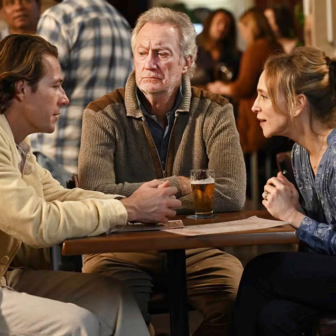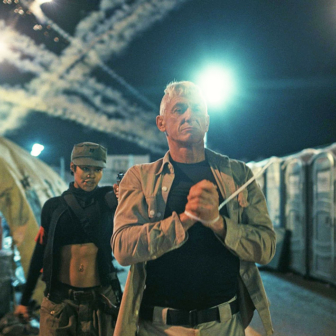LIKE HER subject in this particular cinema portrait, Margarethe von Trotta was prepared to take a great professional risk with Hannah Arendt. This work has been called a biopic; it’s not, if that term means any kind of life story. It is, however, a telling of history; the truth-claim is there in the use of archival footage showing elements of the trial in Jerusalem of Adolf Eichmann in 1961. We look at the man as he was, in the glass box of the dock. The account takes up one period in Arendt’s life, the time in the early 1960s when she won her brief to cover the trial for the New Yorker. The risk for von Trotta, an eminent survivor of the brilliant New German Cinema of the 1970s, was in her conviction that this part of the Arendt story could work as film: a film about a woman who was an intellectual, a trained philosopher dedicated to political thought and argument, getting caught in a blazing controversy. Some reviewers have found the film rather plodding – perhaps an effect of booklined interiors with old-fashioned, clacking typewriters, desks stacked high with documents, the signs of lives given to thinking and teaching. But the action flows, and there is clear light in the Riverside Drive apartment and a fine sense of New York as seen by European eyes.
Not a love story, though the threads of two such stories are woven into it; and no glamorous figure at the centre – Barbara Sukowa, a clear and determined choice by von Trotta, gives us a solid, middle-aged, chain-smoking Hannah. As it happens, she looks nothing like Arendt (though oddly enough Friederike Becht, playing her younger self, is very like the photographs of Arendt at nineteen). Sukowa, however, makes thinking palpable and visible; in the main courtroom sequence, her shifts of expression are mesmerising. On a second viewing, I noticed the array of ultra-sensible knitted suits; whatever Arendt actually wore, the costume and design departments did well. This woman isn’t there to be a heroic individual, or to draw us into personal dramas.
Those were done with, as the story goes, by the time Arendt (1906–75), having escaped the Nazi regime and survived a grim French internment camp, reached New York and shelter, in her second marriage, to the autodidact and former Communist Heinrich Blücher (Axel Milberg). She enjoyed success, as both writer and academic, after the publication of her two massive essays, The Human Condition and The Origins of Totalitarianism. When the world got the news of Eichmann’s capture by Mossad – sketched here in a beautifully ominous pre-credit sequence – she was fired up. The New Yorker didn’t choose her; she came knocking, but her prestige was high enough by then for its editor, William Shawn, to send her to Jerusalem. As Shawn, Nicholas Woodeson gives a most satisfying picture of the unpretentious, workaday editor whose job is his life. He has considerable patience; Arendt will overstrain it, and he has to argue with a hostile colleague who insists, correctly enough, that philosophers don’t know anything about deadlines. In that role, Megan Gay communicates a fine degree of spite: an ill wind from the old hostility between journalism and academia.
If that tension was actually in play, it was nothing on the hate and fury Arendt confronted when her articles were published, followed by the book that was made from them (Eichmann in Jerusalem: A Report on the Banality of Evil). Refusing to demonise Eichmann, taking him at his own word that he was an obedient functionary (the man who checked on the paperwork, made sure the required numbers were locked in the cattle trucks and the trains running on time), insisting on his dreadful ordinariness, she was in trouble. In her New York world, the population of German-Jewish immigrants and survivors couldn’t bear to see Eichmann and his ilk as anything but monsters. She was in even more trouble with her allegations that certain Jewish leaders had collaborated, giving the Nazis, in detail, the required information against their own communities. For this she was attacked furiously and very publicly. Blücher, and a tight group of friends, kept her afloat.
The embattled conviviality of that group, “the tribe,” is vividly choreographed here, with Janet McTeer as a cheerfully acerbic Mary McCarthy. Under pressure to take leave from teaching, Arendt carried on, ostracised by colleagues; here she is looked at steadily, in middle distance, in the college refectory, eating lunch alone. Then she is lecturing her students on the necessity of thinking, finding the distinctions between beauty and ugliness, right and wrong. That eight-minute sequence is a tour de force; lectures aren’t generally supposed to be the material of cinema, but the sustained energy of Sukowa’s performance holds us watching, as it is seen to hold the students.
Arendt’s critics were never silenced; in later generations, the attacks go on, and there are those today who continue to argue that her insistence on “banality” dishonoured the Jewish people’s suffering in the Holocaust. They thought, in short, that Arendt let Eichmann off the hook. It was not so; she merely asked them to see that his mentality was not exceptional. That was too much to ask; it was shocking.
Thus the film bears freight to be unpacked. It asks us to turn the famous phrase around, and look at the evil in banality. The banality, for instance, of long, futile days in island detention centres, the banality and destructiveness of boredom; the banality of “the market” as a ruling central idea, and then the extreme banalities of knights-and-dames and operation-sovereign-borders: roadblocks to thinking, remembering, imagining. Von Trotta’s film asks us to shift the roadblocks, to grow up in our own time and place, to remember what was at stake in Arendt’s life and projects. She demanded that we understand the consequences of unthinking obedience: Eichmann’s kind of obedience.
IN UTTERLY different cinematic terms, Rithy Panh’s French-Cambodian documentary essay The Missing Picture communicates similar messages; but while the backstory to Hannah Arendt is well known to Euro-centred Australians, Cambodia’s ordeal in the later 1970s, recent though it is, is still a cloudy patch in the field of general knowledge. This astonishing, small-scale film affirms the ethical demand that the very worst of times – in this case, the four years of the Khmer Rouge – must not be forgotten; it enacts and displays the need to work with memory, to transform it. It also overrides the notional boundaries between documentary and fiction; it is theatrical, in the best possible sense.
With infinite care, the hands of an invisible sculptor are seen refining a small block of clay, using a knife and then a paintbrush, until it becomes the figure of a man. A population of such figures emerges, to represent the Cambodian people as they lived through a time of brutal oppression, a regime amounting to enslavement. They are so devised that each of them, a blunt, squat dwarf, suggests a dehumanised state while somehow managing to be human, and humanly expressive.
The narrating voice is hypnotic. The story seems to be the film-maker’s own, telling us how memories of his childhood and adolescent years pursue him into his middle age, refusing to be silenced; his father and mother, and other mothers known to him, demand to be remembered. There were parents who chose to sink into death rather than accept the wretchedness being forced on them; one was accused by her nine-year-old son of stealing fruit, made a criminal for it, and taken off into the jungle to die. There was the labouring young woman, who died in great pain because she was too weak from hunger to give birth. There were those who ate rats and insects.
There are images of jungle leafage, corn, rice fields, green growth rippled by wind, interlude moments when the screen is filled by thrashing waves. Behind foreground movement, there is archival film – grainy, splintered black and white – showing lines of peasantry toiling in the fields, and glimpses of huge rallies in which Pol Pot and his cadres harangue their people. Under and through the traces of actuality, with images of endurance in the humble clay figures, there are long sounds from double bass and percussion, probing and searching. In the present, digging the earth in the old pits, they find the skulls, and hard labour goes on and on. The storyteller recalls that it’s supposed to be good to talk, and he lies down among his witnesses; there’s a large photograph of Freud above the couch. But while one person may learn to live with his memories, the music and the incoming sea tell us that the losses have been immeasurable.
Rithy Panh did some film training in France; clearly, he knows his Chris Marker and his Godard, masters of the film-essay; but his goals here are his own, and perhaps Cambodia’s.
IN THE DECADES since the publication of Robyn Davidson’s best-selling travel tale Tracks, there have been several proposals for film versions. Luckily for the story’s persistence in the general culture, the one we have now was directed by John Curran (We Don’t Live Here Any More, The Painted Veil), with a script, by Marion Nelson, sticking closely to the book. Back then – and I remember reading it in 1980 – it seemed like a great cure for the general straining after hyper-sensitive literariness, and we could welcome Davidson’s energetic refusal of the liberal cant of her day. Now, as perspectives shift, it becomes a vivid Australian document out of that time, and not least a book about people and animals.
The film doesn’t transmit Davidson’s fierce, incessant self-questioning; it does give us great performances, and in Mandy Walker’s splendid cinematography, stunning images of the desert in its ranging variety (although my Central Australian friends protest that the South Australian locations were untrue to the story’s map). Mia Wasikowska fully inhabits the nomad’s role, and makes understandable Davidson’s fierce drive to make her odyssey on her own. That being so, it is a feat of acting and direction that Adam Driver’s gentle Rick Smolan wins his own share of sympathy. The camels and the dog are superb performers; the older women, battlers of the tracks, are fine portraits by Felicity Steel and Carol Burns; and John Flaus does a highly enjoyable job as Sallay the camel man. While there’s a bit too much of Garth Stevenson’s music, the fragments of 1970s pop help place the tale in history; and when we reached the last sandhills and the sea, we could go with the orchestral upsurge – it was earned. The director is American, but this film is still an Australian object to value, a lyrical treatment of an important and quite un-lyrical book.
PAOLO SORRENTINO’s The Great Beauty is still running after many weeks, a tribute to its charm and perhaps to the sharpwitted presence of the unsinkable Toni Servillo as Jep Gambardella, the has-been novelist who rambles through Roman society, never able to repeat his single star performance, and wearied in the round of flirtation and seduction. His sixty-fifth birthday party, thickly populated by beautiful people, works as a wake-up call, but he doesn’t know how to go on from there. What should a Gambardella do with all his luck and privilege, what does it mean to inhabit the one per cent? What do you do with the knowledge that the great love of your long-lost youth has died? There’s a vanishing giraffe, a knowing female dwarf, a 104-year-old nun who crawls up a great stairway – she looks disconcertingly like Mother Teresa – a parade of prostitutes, wild young dancers, the sculptural glories of the city, and a lovely, dreaming tour of the river.
Repeatedly, commentators have seen this film as a revival of Fellini in the mode of La Dolce Vita, with Servillo doing a Mastroianni kind of alienation; this misreads both director and performer. Sorrentino has more fun with that world than Fellini ever did; while the main character may be jaded, the film in total is not. The writer may find his way back to writing; he may even need a road away from Rome. I know people who loved this whirling circus so much that they went back three times; but I think Sorrentino’s trip to America, This Must Be the Place, was really more interesting. As with Hannah Arendt, the foreign gaze sees otherwise, sometimes seeing more. •





